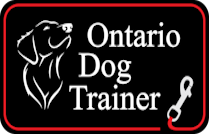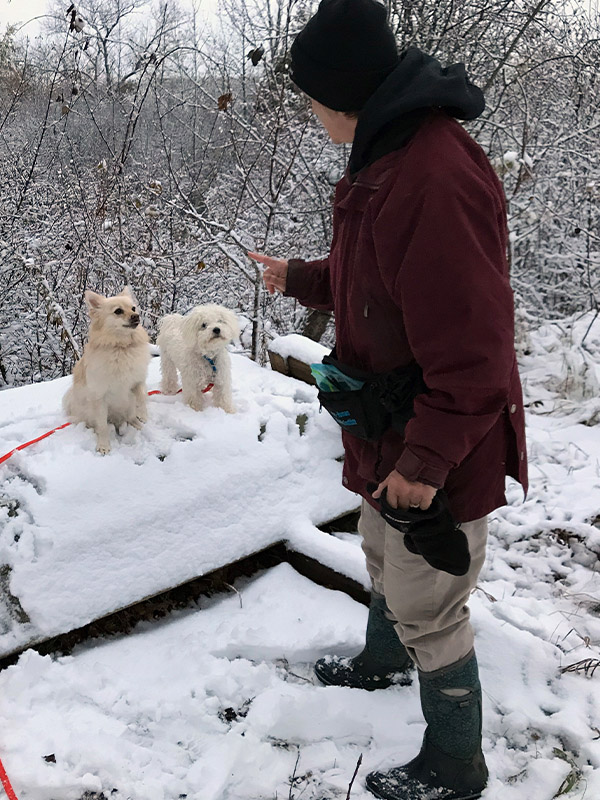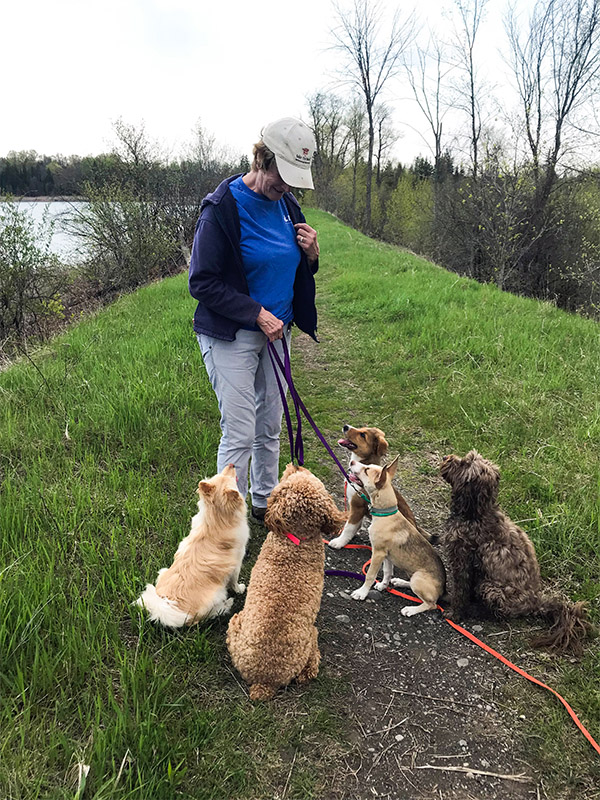1. I DON’T HAVE TIME TO TRAIN MY DOG. WHAT IS MEANT BY “TRAINING TIME IS ALL THE TIME?”
The reality is that it is not how you train your pup it is how you live with him.
‘Living with’ is ‘training’ – all the time. When you live a life of inclusion with your dog, you are always training by setting rules, and standards of behaviour that you are wiling to tolerate. – Either you are training your dog, or your dog is training you. The good news is… YOU get to choose!
Remember: Real results equal 10% trainer 90% owner.
2. I JUST BROUGHT HOME A NEW PUPPY, AND HE IS DRIVING ME CRAZY!! PLEASE HELP!!
Whether you have a new puppy or a new-to-you older dog that you have adopted, the basic elements for success are similar:
1. Quality nutrition,
2. Predictable daily structure and routine,
3. Crate training/potty schedule,
4. Drag Line
a. Quality Nutrition: Dogs and puppies learn best when their brains and tummies are fed a nutritious diet on a predictable schedule. Check out www.dogfoodadvisor.com for a quality food that is suitable to your pup’s age. Select a food that is rated at 5 stars. Always provide variety to keep your dog’s digestive system active – adding fish oil, canned meat and regularly changing the primary protein in your dog’s kibble or raw diet are important contributors to a healthy digestive system.
b. Predictable Daily Structure and Routine: Start your puppy off right with a predictable daily routine. They will learn to go outside for potty, sleep through the night more quickly and will rest more frequently when they can count on the activities associated with work-rest-play to happen at the same time every day. Dogs thrive when they know to expect for exercise, rest and eating. If your dog’s meal times are similar to your meal times, your dog will place a high value on meal times and you can capitalize on this time as training opportunity by teaching pup to sit and wait until you give permission to eat.
c. Crate training/potty training – Like babies, puppies needs plenty of undisturbed rest. This is where a crate becomes your best friend. When you cannot supervise your puppy, give him a quick potty break and then put him in the crate for a rest. Ignore any protesting. HE will be fine. Scheduled crate rest is closely connected to scheduled potty breaks. Most healthy puppies do not like to go potty where they sleep. Take your puppy outside (always through the same door to the same place in your yard) for a potty break as soon as he comes out of the crate. This routine of crate time followed by potty break will quickly create a good habit for your puppy to know when and where to go potty. Never put your puppy in its crate as punishment. Crate time is calm, rest time … for everyone!
Remember: Training time is all the time. A ‘formal’ training session (e.g. come or sit) should take about 5 minutes two or three times per day. The remainder of your day is about ‘living with’ your pup in a way that creates an awareness of doing things right to create your dream dog for your life together.
Contact Ontario Dog Trainer to learn more about how our specialized Puppy Packages can ensure that your puppy becomes the dog of your dreams!
3. WHEN SHOULD I START TO TRAIN MY PUPPY TO BE COMFORTABLE IN A CRATE?
The best time to introduce your puppy or new dog to a crate is on your ride home from the breeder or wherever you are picking him or her up. Crates create a feeling of security, self-relaxation and calmness for your dog. Knowing that your pup is safe and comfortable in its crate, enables you to maintain your sanity and to have a life of your own.
If your dog is not accustomed to sleeping in a crate the best time to start is now. . A schedule to help your puppy or new dog accept a crate should begin immediately and continue until adulthood or until your dog can be trusted to sleep unsupervised, in your home, outside of a crate.
Remember: When introduced properly, a crate will become your dog’s sanctuary. You want to your puppy to grow up with a mindset that ‘the crate is great!’
Contact Ontario Dog Trainer to learn how your puppy can learn that the crate is great!
4. WHERE SHOULD MY PUPPY SLEEP AT NIGHT?
If you introduce your puppy to a crate from day 1, the crate will be where it wants to sleep at night. The crate can be covered and have a snuggly blanket and/or toy to help the dog feel safe, comfortable and protected, just like a den.
When you develop a bedtime routine that includes a final potty break, followed by a yummy bedtime treat in their crate, your dog will perceive its crate to be a great place to be! Eventually, you will be able to leave the crate door open or replace the crate with a bed and your dog will choose to go the same space to sleep.
Remember: the saying to ‘let sleeping dogs lie, is most important when puppies and dogs are resting in their crates. Leave them be!
Contact Ontario Dog Trainer to learn how your puppy can learn that the crate is great!
5. HOW CAN I STOP MY PUPPY FROM NIPPING AT MY HANDS WHEN I TRY TO TOUCH HIM?
The best way to stop a puppy from getting too nippy is to not let that behaviour get started in the first place. Puppy’s will often nip or use their mouths inappropriately when they are over-tired. If your puppy has been out of its crate for longer than an hour, there is a good chance that it is nap time. Put him in the crate, cover it with a blanket if needed, and let pup rest.
If there is a lot of chaos, such as when one or more small children are actively running around or screaming with joy, and puppy gets too nippy, if possible have the kids ‘act like a tree’:
1. Stop moving;
2. Stand still (like a tree);
3. Fold their arms (tree branches)
4. Look up (to the sun)
When this happens, puppy will quickly become bored with the inactivity and will shift focus elsewhere, which may enable you to put him in the crate, or have the kids resume a calmer play activity.
Remember: Sound is energy. Yelling or screaming at your puppy when he nips, may cause him to nip harder.
Contact Ontario Dog Trainer for help with your puppy’s mouth manners.
6. HOW OFTEN SHOULD I TOUCH MY PUPPY’S FEET?
Teaching your puppy to accept its feet being touched is an act of trust. If you start gently touching your puppy’s feet from day 1, it will be easy for you to dry wet feet, remove snow from between its toes, trim nails, remove burrs and check for cuts as your dog matures, because he will trust that you mean no harm.
A great time to practice this exercise is each time you invite your pup out of its crate, or when you come in from outside. Create a habit by having your dog sit as soon as it comes out of the crate or comes in from outside. When pup is sitting calmly, touch his feet individually, in the same order each time. Initially touch each foot quickly as you label or explain what you’re doing. Gradually extend the length of time that you hold each foot until your dog accepts your touch and holding. Remain calm and speak softly. With consistent practice, your dog will learn the sequence and you may find he offers each foot even before you ask for it!
Remember: touching your puppy’s feet in a calm, consistent way is a great way to build your bond of trust together. Practice calmly and gently touching your dog’s feet daily.
Contact Ontario Dog Trainer to learn fun ways to teach your dog to trust you to touch his feet.
7. IS IT OK TO ALLOW MY DOG/PUPPY ON FURNITURE?
If your dog is respectful to you as leader and is well behaved to family members and guests in your house, the option of allowing access to furniture is up to you. If your dog has ever bitten or growled at you, family members or visitors to your home who may want to sit on the furniture, access should be denied for life.
Remember: The body ‘on top’, is the body in charge. If your dog is on your furniture, there is a good chance that it will perceive itself to be higher than you on the leadership hierarchy. This perception could lead to behaviour problems.
Contact Ontario Dog Trainer to learn alternatives to furniture access for your dog.
8. MY PUPPY LOVES EVERYONE AND PULLS TOWARD THEM TO ‘SAY HI’ WHEN WE ARE WALKING ON LEASH. SHOULD I ALLOW THIS?
No. All puppies are people magnets. It is up to YOU to manage how and who your puppy meets. Allowing your puppy to dismiss your presence and pull you towards another person is just as annoying and risky as people invading your pup’s personal space without permission.
Remember: All touch by strangers, should be on the dog’s terms. Allowing people to help themselves to your dog’s personal space jeopardizes your role as leader (in your dog’s eyes) and may put both your dog and the approaching person at risk.
Contact Ontario Dog Trainer to learn a safe and effective way to enable your dog to meet people.
9. MY PUPPY LOVES ALL DOGS. SHOULD I LET MY DOG OR PUPPY MEET OTHER DOGS DURING OUR LEASH WALKS?
No. Allowing your pup to meet dogs that you do not know is irresponsible and could put yourself and your dog or puppy at great risk. Owners often either have no control over their dogs or will let their dogs ‘go’ and then yell “it’s ok, he/she is friendly” at just about the same time that a fight breaks out.
Remember: Puppies and adult dogs should NEVER be allowed to approach a dog that they or you do not know, and similarly, you should NEVER allow an unknown dog to approach your puppy. Your puppy’s life could depend on it.
Contact Ontario Dog Trainer to learn our unique and safe approach for dogs meeting dogs.
10. HOW MANY TIMES PER DAY SHOULD I FEED MY DOG?
The most important rule about feeding your dog is that it should be fed a nutritious diet, on a schedule that is determined by you and that follows roughly the same time schedule daily.
Puppies do best by eating several small meals per day—usually morning, noon, mid-afternoon/early evening, and again in the evening. Once they are six months or older, a schedule of feeding two times per day, in the morning after your morning walk together and evening just before your dinner time often works best.
Once your dog reaches the senior years, they may again benefit from multiple daily feedings similar to a puppy-feeding schedule to keep them energized and strong.
NEVER leave food in a bowl on the floor for your dog to ‘graze’ all day long. This is unhealthy for the dog, is a lost opportunity for training, and relegates you to the role of servant to the dog.
A general rule when feeding kibble is to feed approximately 30% LESS than what is recommended on the bag. Manufacturers deliberately pump up the recommended feeding amount as a marketing strategy.
Remember: ALWAYS provide access to plenty of water all day long. Ensure that your dog and you get plenty of exercise together and monitor your dog’s body condition. Obesity kills more dogs than any other disease.
Contact Ontario Dog Trainer for more information on canine nutrition.
11. HOW MANY TIMES PER WEEK SHOULD I WALK MY DOG?
At a minimum, your dog should receive a brisk walk before each meal as a way to simulate ‘hunting’ for food. At the conclusion of the walk, when your dog sees that a highly-nutritious meal is provided by you, he will respect you as the best hunter ever! Include time walking on leash with you, and off leash in safe settings, to give him a chance to sniff and enjoy freedom during each walk.
Puppies should also be walked before each meal to establish a working mindset and to tap into their need to ‘work for food’.
Remember: Movement diffuses tension – for your dog and for you! Walking with your dog offers so many benefits for both of you. In addition to the obvious benefits of exercise, it is an easy way to establish a relationship and build your bond with your dog. If walking a puppy, keep your sessions short and fun so that your puppy learns to stay focused on YOU!
Contact Ontario Dog Trainer to learn more about how to build good leash manners with your dog.
12. HOW CAN I STOP MY DOG FROM PULLING ON LEASH DURING WALKS?
When done properly, daily walks are the most effective way to establish your role as leader of the pack and to build a relationship of trust and respect with your dog. Be sure that your dog does all of his potty business prior to starting your walk. Remaining calm and focused forward while walking will ‘talk to your dog’ through the leash in a way that tells him that you are in charge and he is safe to follow your lead.
Remember: Movement diffuses tension. If your dog is lunging and barking at dogs or people,
Contact Ontario Dog Trainer to learn how to transform your reactive dog to a responsive dog.
13. HOW CAN I GET MY DOG TO DROP THINGS THAT I DON’T WANT HIM TO HAVE?
Many breeds are genetically coded to put things in their mouths (e.g. retrievers, poodles, some pointer breeds). Dogs that are bored and puppies who are excited may pick up slippers, toys, and other things to race around the house.
There are many ways to teach a dog to release something from its mouth. In the early stages of developing your relationship, keep a six-foot drag line attached to your puppy’s collar to enable you to provide guidance to come to you when asked to exchange the object for a yummy treat. Teach your dog that coming to you will ALWAYS produce a reward and praise. Once your pup learns that bringing something to you earns a reward, a good habit will quickly become established and the risk of damaged shoes will diminish!
Remember: Dogs need jobs. When your dog brings you something, he is working for you! Remain calm, and praise profusely as you exchange the object for a treat.
Contact Ontario Dog Trainer to learn about other jobs that your dog can learn to do for you.
14. ARE DOG PARKS SAFE FOR ME AND MY DOG?
In most cities, dog parks are largely unregulated and unsupervised. Not every dog owner is responsible when it comes to training or keeping their dogs free of disease and parasites, nor are they considerate when it comes to picking up after their dog. One way that dangerous internal parasites are transferred between dogs is from feces. Many parasites persist in the ground even if the poop is scooped. If your dog smells that ‘spot’, the parasite eggs may be transferred to your dog through inhalation.
Unless you have a reliable play group of trusted ‘friends’ that your dog knows and gets along with, a dog park can be chaotic and dangerous for your dog. Dogs thrive on pack structure and knowing who is in charge. In a dog park, the number of ‘pack leader dogs’ changes with whoever is in the park when you enter. If your dog is perceived as the ‘new dog in the park’ or the ‘weakling’, he may get bullied and possibly injured by another dog or group of dogs.
Remember: If a dog park is your only option for off leash exercise for your dog, here are some tips for success:
1. Movement diffuses tension and your energy and focus is stronger when you move: When you enter the park KEEP MOVING! If your dog sees you as leader, it will follow YOU and will not get into trouble with other dogs.
2. Do NOT take any toys or food into the park. Tossing a toy for your dog or offering food to any dog in the park, may create a competition with dogs whose ability to ‘share’ are unknown to your or to your dog. The result can be catastrophic for both you and for your dog. Don’t do it.
3. Keep your hands to yourself. Do not pet any dog that approaches you. Giving affection to an unknown dog can cause a fight with other dogs, including your dog, who will want to compete for your attention.
Contact Ontario Dog Trainer to learn more about our ‘play dates for grads’ and never worry about Dog park chaos again.
15. MY DOG RACES AROUND THE HOUSE AT NIGHT LIKE A CRAZY DOG. IT IS HILARIOUSLY FUNNY. SHOULD I STOP THIS BEHAVIOUR?
Enjoy it! Like toddler time, this fun behaviour doesn’t last forever. Like children, some dogs have ‘imaginary friends’ that they ‘play’ with at certain times. As long as it is harmless and your dog is safe, let it go! To interrupt or take away a dog’s self-induced joy erodes its self-confidence and compromises your relationship.
Remember: even as adult dogs, a dog’s brain has the maturity equivalent to a toddler. Dogs are born to serve and to have fun in the process. Enjoy every moment with your dog, they are not with us long enough.






